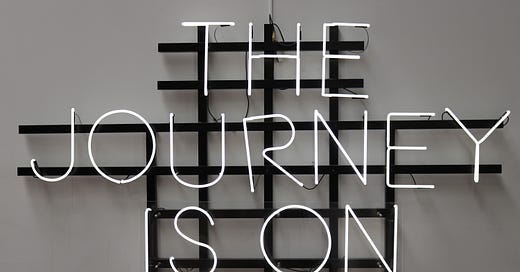In full transparency, I’m sharing my journey to Design Your Delta because, for me, this project is an explicit effort to influence the transformation of lawyer formation. I’m doing what I can, where I am, with what I have.
Influence happens at the convergence of ethos, pathos, and logos.1 In posts no. 1 and no. 2, we started exploring the logos of Design Your Delta. Alyson’s journey shared in post no. 3, along with mine, combine to create the ethos. Who are we to be doing this? And why would you trust us, and hopefully join us in this journey to reimagine professional formation for lawyers?
I’ve been a licensed lawyer since 1998 and practiced law full time for nearly 20 years before I started teaching at my alma mater Vanderbilt. I’m also a 5th generation lawyer, growing up in my father’s law office, which stood in the shadow of the local courthouse. Where a bust of my grandfather, a Kentucky circuit judge, still stands at the entrance. My great-great-great-uncle? Chief justice in the 1860s of what is now the Kentucky Supreme Court.
I have big shoes to fill.
And, the nexus of my lived experience with the deep obligation I feel to the profession is the wellspring of my passion to #makelawbetter through Design Your Delta.
I learned the skills of lawyering by doing the work, yes. Observing and doing are two primary ways we humans learn most effectively.2 And, I realized in law school that there were many things I could have been doing then, to support that learning. But, the opportunities to do so didn’t exist.
I spent a lot of time in law school asking why?! about the traditional pedagogy, based on what we know about how humans learn and my own experiences as a learner and a teacher.
In most respects, holistic learning opportunities still don’t exist in legal education.
And these opportunities focus largely along the Process and People sides of the Delta—opportunities to build skills that much of the research confirm are critical to effective lawyering. And skills that are relegated to silos in the curriculum, at best. At worst, the curriculum ignores them.
My awareness of this gap grew as I grew as a lawyer. Eight years into the practice, I created a firm with two other women, with the purpose to redefine how we worked and how we served clients. I learned core entrepreneurial and tech skills while building this firm, and this experience continues to inform everything I do today.
Now, I have the privilege of spending my time studying and learning from legal professionals across the spectrum of practice, to understand the skills they need and the challenges and opportunities they face. Concurrently, I study the needs of people our systems of justice are supposed to serve. Most of whom go without any legal help at all.
And, I study how all of this exists within and relates to the world around us, in this Fourth Industrial Revolution. So, I’m focused not only on understanding the skills we lawyers need to thrive and succeed and serve based on what we know so far but also on how we skate to where the puck is going, to understand what we will need as the future unfolds.
Can we learn from what we know has worked so far? Yes. And, we can’t be limited by this frame. We need a broader, more holistic frame to guide lawyers through the formation process—a process which never really ends—to better prepare us to serve in the 21st century.
We need the frame of humble curiosity, which Mary Oliver captures so perfectly in her poem “Luna”:
I live
in the open mindedness
of not knowing enough
about anything
Because, what got us here will not get us to where we need to go, to serve the vast, unmet needs that currently exist across our systems of justice. Or address the many, many challenges faced within and across our profession.
This is why I am helping to build Design Your Delta.
Before law school, I studied rhetoric and persuasion and taught the art of influence at two large public universities as part of my master’s work in rhetoric and communication.
For an overview on how we learn, see “How People Learn: Introduction to Learning Theories”.



